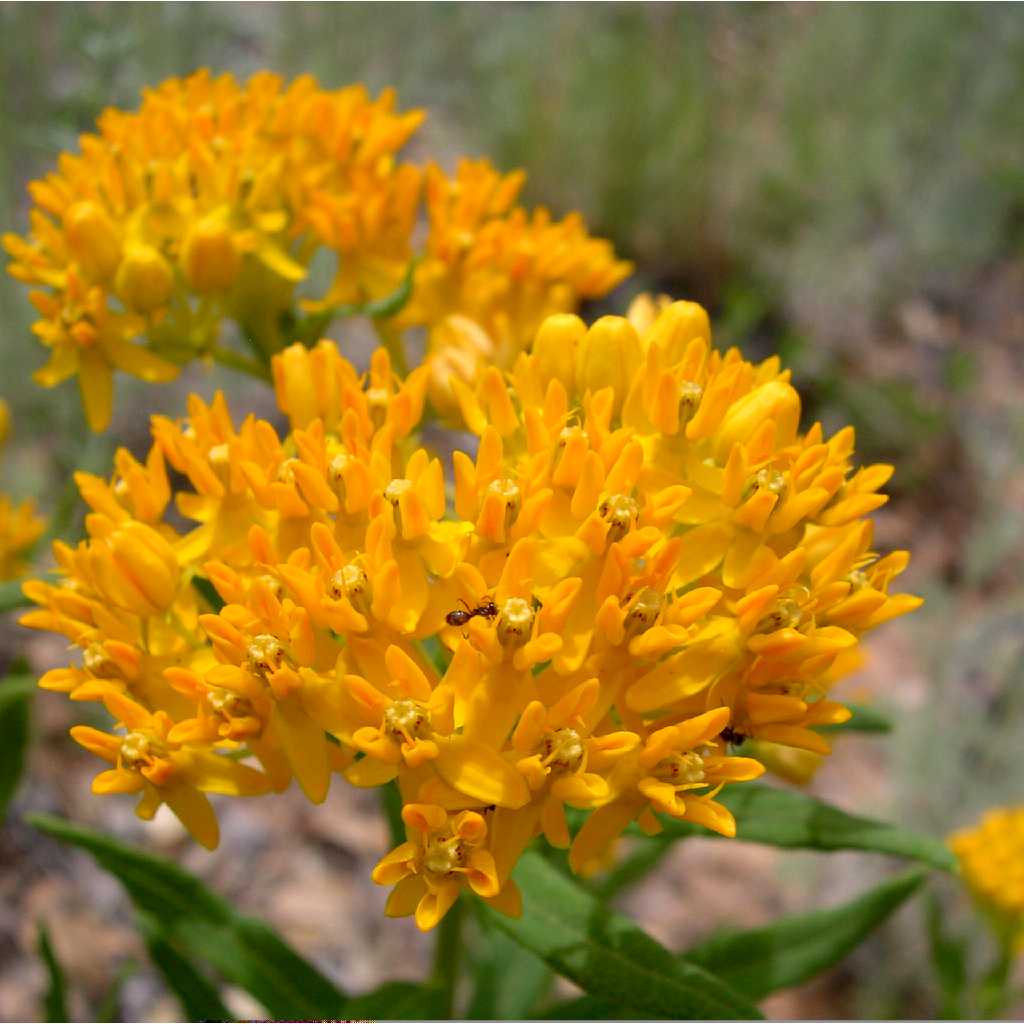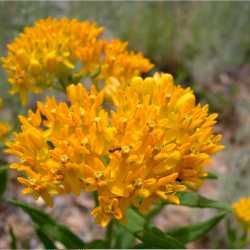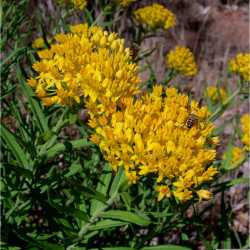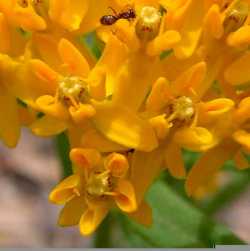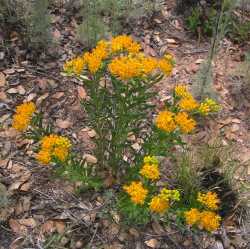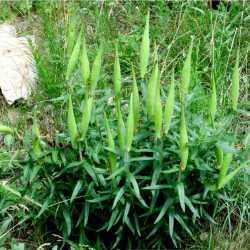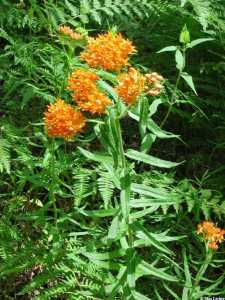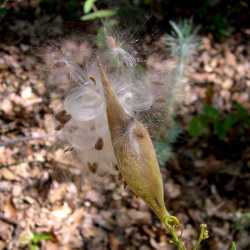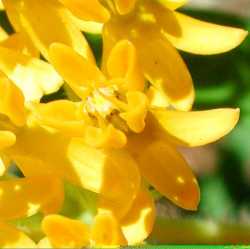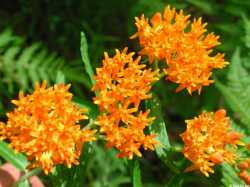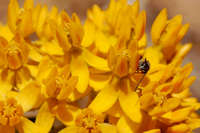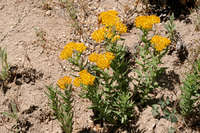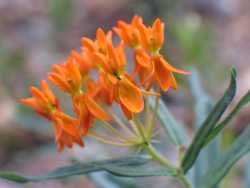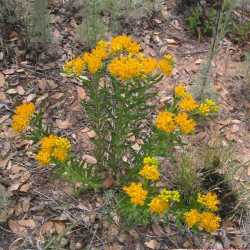Plant: perennial herb; stems erect or ascending, branching only in the inflorescence, 20-80 cm tall
Leaves: irregularly alternate, usually crowded, distinctly short-petiolate, the petioles 1-2 mm long, the blades lanceolate, linear-lanceolate or narrowly oblong, 2-10 cm long, 3-15(-22) mm broad, acute apically, acute to mostly obtuse, rounded, truncate, or subhastate at the base, pilose beneath particularly on the veins, pilose to somewhat hirsute above; no milky sap
INFLORESCENCE: UMBELS lateral and subterminal, simple to irregularly compound, 3-5 cm broad, typically clustered at the uppermost nodes forming a more or less flat-topped to rounded secondary inflorescence, the peduncles indistinct to mostly 1-6 cm long
Flowers: medium size; calyx lobes 2-3 mm long; corolla bright orange or less commonly yellow, the lobes 6-8 mm long; hoods orange to yellow, erect or ascending, lanceolate to oblong, attenuate above the middle to a rounded apex, 4-5.5 mm long, 1-2 mm broad, ca. 1.5-3 mm longer than the gynostegium, the horns attached below the middle of the hoods, digitate, exserted 1-2 mm and more or less arching over the stigma head; anther wings 1.8-2 mm long; corpusculum 0.2-0.3 mm long, the pollinia 1.2-1.4 mm long
Fruit: FOLLICLES erect on deflexed pedicels, 7-13 cm long
REFERENCES: Sundell, Eric. 1994. Asclepiadaceae. J. Ariz. - Nev. Acad. Sci. Volume 27, 169-187.
Infrequent throughout the state except in the sandy areas of the lake region where it becomes frequent. It is usually found on dry, sandy, roadside knolls, or in dry, sandy, open woodland and in moist or dry, sandy prairies. This species is variable in habit, sometimes almost erect, usually somewhat ascending, or rarely almost decumbent. It is also variable in the number, position, and shape of the leaves on the stem. The stem divides at the top, usually into 2-5 parts, these sometimes much elongated and spreading, and each bearing 1-5 umbels of flowers.
Duration: Perennial
Nativity: Native
Lifeform: Forb/Herb
General: Erect or ascending stems from deeply woody root, stems clustered, branching in the inflorescence, 20-90 cm tall, herbage hirsute to hispid, with watery (not milky) sap.
Leaves: Irregularly alternate, usually crowded and very variable, with distinctly short petioles 1-2 mm long, topped by lanceolate, linear-lanceolate to broadly oblanceolate blades 2-10 cm long, 3-15 mm across, the tip acute, the base rounded to truncate, pilose below, pilose to hirsute above.
Flowers: Umbel inflorescence terminal or nearly so, 3-5 cm across, clustered at uppermost nodes, the peduncles indistinct to 1-6 cm long, the flowers with calyx 2-3 mm long, triangular, the corolla reflexed to rotate, orangish to reddish or yellowish, the lobes 7-8 mm long, the hoods orange to yellow erect, lanceolate to oblong, 4-5.5 mm long, 1-2 mm across, the horns attached below the middle of the hoods.
Fruits: Follicles erect on deflexed pedicels, narrowly fusiform, 8-15 cm long, 1-1.5 cm across.
Ecology: Found a variety of habitats from chaparral, to pine, to riparian woodlands, meadows and disturbed sites from 3,000-8,000 ft ( 914-2438 m), flowers May-September.
Distribution: Widespread across North America, north Canada and south to northern Mexico, there are four subspecies continentally in a rough east to west gradient.
Notes: Ours is likely subsp. interior which is distinguished by the narrow leaves with obtuse to truncate bases. Toxic to livestock. The species is widely cultivated throughout the U.S. Average 69,560 seeds per pound. This is a limited monarch host plant.
Ethnobotany: Used for stomach and intestinal pains, for diarrhea, as an expectorant, for heart trouble, taken for lung troubles, as a laxative, for rheumatism, as an aid in child birth, taken for swellings, for cuts, as a tonic, and as a ceremonial medicine.
Etymology: Asclepias is named for the Greek god of healing Asklepios, while tuberosa means bearing tubers.
Synonyms: Asclepias decumbens, Asclepias floridana, Asclepias lutea, Asclepias tuberosa var. decumbens
Editor: SBuckley 2011, 2014, AHazelton 2015
Ascending or erect, 3-7 dm, rather coarsely hairy, simple to much branched above; lvs numerous, alternate or on the branches opposite, linear to lanceolate or oblanceolate, 5-10 cm, cuneate to subcordate at base; juice not milky; umbels solitary and terminal to numerous; fls bright yellow to orange-red; cor-lobes 7-10 mm, the hoods 5-7 mm, greatly exceeding the gynostegium, nearly straight, erect, the lateral margins bearing an obscure tooth below the middle; fr 8-12 cm, erect; 2n=22. Prairies and upland woods, especially in sandy soil; s. N.H. to Fla., w. to Minn., S.D., Ariz., and Mex. June-Aug. Var. tuberosa, with the lvs typically widest above the middle, hence abruptly pointed, is the eastern phase of the sp., chiefly in and e. of the Appalachian Mts. in our range. Var. interior (Woodson) Shinners, with the lvs typically widest below the middle, hence tapering gradually to the tip, is more western, chiefly w. of the mts. in our range. Intermediates are abundant.
Gleason, Henry A. & Cronquist, Arthur J. 1991. Manual of vascular plants of northeastern United States and adjacent Canada. lxxv + 910 pp.
©The New York Botanical Garden. All rights reserved. Used by permission.


